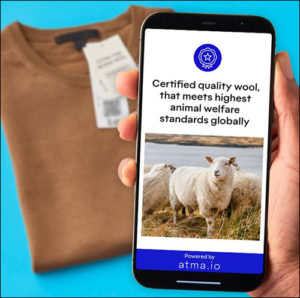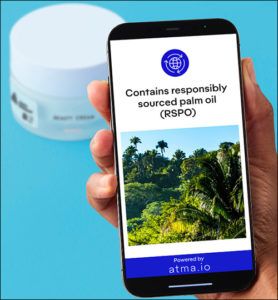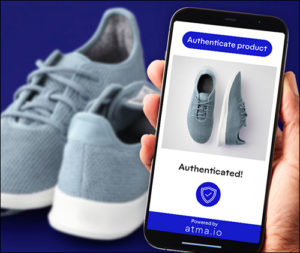Avery Dennison has launched an Internet of Things (IoT)-based platform aimed at centralizing digital ID creation and management to uniquely identify and monitor goods at the item level from manufacture to supply chains and stores, as well as after purchase by consumers. Atma.io is a cloud-based platform for managing data related to product digital identities, whether they are captured by QR code, Near Field Communication (NFC) or UHF RFID. “It’s designed to work with any digital trigger,” says Max Winograd, Avery Dennison’s VP of connected products.
Although Avery Dennison is announcing the solution launch this month, the technology has been tested and employed at scale by numerous businesses for the past two years. These early adopters are what the company calls its lighthouse customers, and Winograd says the platform has already managed data collected from more than 10 billion items, with 50 new products being added to the platform every second.
Those lighthouse companies leveraging the system include athletic shoe and garment maker Adidas, which (through its Infinite Play program) uses the solution to identify products for reuse and ecommerce. Last week, Adidas announced that it will expand Infinite Play to the Americas later this year. The company intends to provide the feature, using QR codes that can be scanned by consumers, for all 1.2 billion products it manufactures annually. It also utilizes RFID technology for inventory management and could add the RFID data to the system in the future.
Other companies that have tested atma.io or are deploying systems leveraging the software, which have asked to remain unnamed, include a shoe brand that captures tag reads from both NFC and RFID tags. That company captures and integrates data from a consumer-facing NFC system with UHF RFID-based inventory-management functionality. The new platform, Winograd says, is intended to address what have traditionally been fragmented solutions for digital identities. Although goods are already being tracked using a variety of technologies at various steps in a product’s life cycle, he explains, there are few existing solutions to digitally track a product end to end.
 While RFID may capture inventory or supply chain data, for instance, the relevant information is not made available to consumers. NFC and QR codes, on the other hand, are being used for product authentication, or to access post-purchase content. However, that is not necessarily linked to information about the product before it was purchased. According to the company, the platform is intended to link the worlds of product manufacturing and shipping with consumer content and authentication, as well as details regarding disposal and recycling.
While RFID may capture inventory or supply chain data, for instance, the relevant information is not made available to consumers. NFC and QR codes, on the other hand, are being used for product authentication, or to access post-purchase content. However, that is not necessarily linked to information about the product before it was purchased. According to the company, the platform is intended to link the worlds of product manufacturing and shipping with consumer content and authentication, as well as details regarding disposal and recycling.
Avery Dennison expects the platform to enable consumers to benefit from viewing data about a product’s manufacturer, its expiration date, or the conditions under which it was shipped and stored. Brands and retailers, meanwhile, could view data indicating how a particular product was used, as well as accomplish a dialog with customers after the purchase has been completed, such as recommending accompanying items or offering maintenance.
The atma.io software, which Avery Dennison describes as the “connected product cloud,” is intended as a mix-and-match solution, Winograd says. While it enables the tracking of goods from factory to consumer, it includes a portfolio of modules that users can select to enable specific use cases, ranging from brand protection to consumer engagement or sustainability. With the platform’s release, Avery Dennison is partnering with technology companies that can provide integration, hardware and software to help businesses more quickly begin capturing and managing data.
Historically, Avery Dennison has sold RFID technology in the form of labels for the unique identification of goods. In October 2019, Winograd recalls, the company first examined how it could take its offerings to a new level, enabling customers to go beyond siloed solutions for unique identification. “We saw a critical gap and decided to get into the software business,” he says. The company was new to the software sector at that time, he recalls, so such efforts were risky and daring.
 “It was the first time for Avery Dennison to set up a software business internally,” Winograd says, “versus partnering with existing providers,” and its goals were ambitious: creating a single source for data that had been previously fragmented. In the case of Adidas, for instance, the system drives the Infinite Play campaign, which enables consumers to turn in used Adidas products and receive a gift card or loyalty club points. The company can receive and identify products being returned, then remanufacture them, thus reducing the need for new or raw materials, while shrinking its carbon footprint.
“It was the first time for Avery Dennison to set up a software business internally,” Winograd says, “versus partnering with existing providers,” and its goals were ambitious: creating a single source for data that had been previously fragmented. In the case of Adidas, for instance, the system drives the Infinite Play campaign, which enables consumers to turn in used Adidas products and receive a gift card or loyalty club points. The company can receive and identify products being returned, then remanufacture them, thus reducing the need for new or raw materials, while shrinking its carbon footprint.
Adidas began using atma.io to enable the system last year, as the Infinite Play project was first launched in the United Kingdom. With the program, customers scan a 2D barcode on a product being returned, using an app from Adidas. The firm then picks up the goods based on that request and provides users with appropriate discounts or coupons. For Adidas, the platform enables a view into a product’s lifetime.
Another company began using the system to link NFC and RFID technology data. Once an RFID or NFC tag is read, the collected data is managed on the platform, providing visibility into inventory and supply chain data, while NFC tag reads can offer further information about goods once they have been purchased. “Now you can create a birth of the product at the point of manufacture,” Winograd says, and each tag read provides new information about an item’s manufacture, shipment or sale.
Another example might be the use of UHF RFID tags for inventory accuracy, with the tags interrogated at distribution centers and stores, along with a printed QR code on each product’s hangtag. Shoppers would use the QR code scan to access a product’s full history. Companies might also employ a dual NFC and UHF RFID tag that could be read by logistics companies and retailers, as well as by a consumer’s own NFC-enabled smartphone following a purchase. There is now a single platform that can address all of these use cases, Winograd says.
 According to Winograd, Avery Dennison is currently working with three of the top five apparel brands on atma.io-based solutions, all of which are capturing at least some data from RFID. The software platform development and release has taken place during the COVID-19 pandemic, he notes; this was not delayed by the outbreak, and use cases may be expanding. For one thing, he says, “COVID has changed consumer behavior, and it has changed needs related to how responsive supply chains need to be.” Those new demands on retail supply chains have accelerated requirements for information and, therefore, technology innovation.
According to Winograd, Avery Dennison is currently working with three of the top five apparel brands on atma.io-based solutions, all of which are capturing at least some data from RFID. The software platform development and release has taken place during the COVID-19 pandemic, he notes; this was not delayed by the outbreak, and use cases may be expanding. For one thing, he says, “COVID has changed consumer behavior, and it has changed needs related to how responsive supply chains need to be.” Those new demands on retail supply chains have accelerated requirements for information and, therefore, technology innovation.
“Brands need the tools to access data more than ever,” Winograd states, “and to make changes based on consumer demands very quickly.” The need for real-time visibility is thus more important than ever, he adds, and having that data all in one place rather than collected on multiple software platforms will enable companies to gain greater insights about a given product and its sale.
COVID-19 may have accelerated the growth of automatic ID technologies like RFID due to the need for consumers to have touchless experiences, Winograd says. RFID enables users to capture data regarding a specific product by simply scanning a tag rather than handling it, while in some cases it allows point-of-sale checkout and anti-theft features, all of which could be included in an atma.io-based solution.
Working remotely, Winograd reports, the company has been able to use the cloud-based software to quickly deploy systems to customers during the pandemic as well. “This can be turned on quickly for brands,” he says, “or for supply chains, and that makes it possible to adapt while being remote.” The development is currently taking place in Austria and Croatia.


